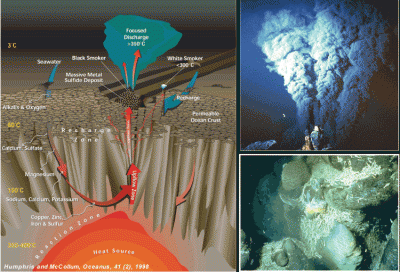
MoMAR (Monitoring the Mid Atlantic Ridge)
Membres de l'équipe impliqués :
M. Cannat, J. Escartin, J. Dyment, S. Singh, W. Crawford, L. Beguery, F. Fontaine, F. Lucazeau
et C. Mével
et les étudiants en thèse :
D. Dusunur, T. Seher, V. Combier
Les dorsales océaniques sont des zones actives où les interactions entre l'intérieur de la Terre (convection mantellique, fusion partielle et migration des magmas, volcanisme et tectonique) et les enveloppes superficielles (hydrosphère et biosphère) sont particulièrement importantes. Pour comprendre ces interactions, une approche intégrée et pluridiciplinaire, dans laquelle les différents processus actifs à l'axe de la dorsale sont abordés simultanément, est nécessaire.

Par des observations et mesures continues ou répétées, sur des échelles de temps de la minute à la dizaine d'années, l'objectif du projet MoMAR est de caractériser l'évolution temporelle de paramètres tels que la sismicité, la déformation, l'activité volcanique, le flux, la température et la composition des fluides hydrothermaux, les flux larvaires, la diversité des micro-organismes, la variété des habitats, et la réponse des organismes à ces variations.
Le chantier MoMAR présente l'intérêt d'inclure plusieurs champs hydrothermaux situés à des profondeurs différentes, et dans des contextes géologiques distincts (en contexte basaltique ou ultrabasique). Sur le plan logistique, ce chantier a l'avantage d'être facilement accessible (proximité des Açores). Le projet MoMAR a été initié sous les auspices du programme InterRidge.

Le projet MoMAR est international et l'équipe de Géosciences Marines de l'IPGP en est un acteur important. Nous sommes en particulier coordinateurs d'un Réseau européen Marie Curie (MoMARnet) qui finance 15 jeunes chercheurs dans 8 pays. Nous participons au nouveau Réseau d'Excellence européen ESONET. Au niveau français, nous coordonnons un projet de l'ANR blanche (projet Mohtesiem), et nous sommes porteurs de plusieurs projets de campagnes à la mer (voir site MoMAR-France) . Nous avons ainsi organisé la campagne de mesure de flux de chaleur Luckyflux en 2003, et la campagne de sismique SisMoMAR en 2005. En 2007 nous sommes co-organisateurs des campagnes MoMARDREAM, BBMoMAR, et Bathyluck.

Institut de Physique du Globe de Paris - Mise à jour 11/2024
Site publié avec e-Lectron - Contact : Webmaster IPGP